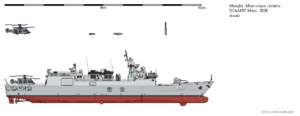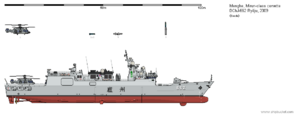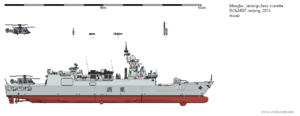Mirun-class corvette
 DChJ-657 Mirun as commissioned in 2008.
| |
| Class overview | |
|---|---|
| Builders: |
|
| Operators: | |
| Preceded by: | |
| Succeeded by: | Yungju-class corvette |
| Built: | 2005-2013 |
| In commission: | 2008-present |
| Planned: | 32 |
| Completed: | 32 |
| General characteristics (Mirun, 2008) | |
| Type: | Anti-submarine corvette |
| Displacement: |
|
| Length: |
|
| Beam: | 13.7 m at waterline |
| Draught: | 3.66 m to keel |
| Propulsion: | |
| Speed: | 30 knots |
| Range: | 4,400 nautical miles (8,150 km) at 15 knots |
| Complement: |
|
| Sensors and processing systems: |
|
| Electronic warfare & decoys: |
|
| Armament: |
|
| Aircraft carried: | 1 × GH-28 Ppulsoeori |
| Aviation facilities: |
|
The Mirun-class corvettes (Menghean: 밀운 중형 대잠수함 초계함 / 密雲級中型對潛水艦哨戒艦, Mirun-gŭb Junghyŏng Daejamsuham Chogyeham) are a group of oceangoing anti-submarine corvettes built for the Menghean Navy in the late 2000s and early 2010s. They are sometimes transliterated as the Milun class, and a few sources regard them as frigates due to their size and capabilities.
Although the Mirun-class and Sŏwicho-class are both labeled as corvettes in most foreign-language literature, and were built simultaneously with one another, the Menghean Navy regards them as "medium" and "small" anti-submarine patrol ships, respectively. Unlike the Sŏwichos, which are purely designed for coastal patrol duties, the Mirun-class vessels are able to conduct long-endurance patrols in the open ocean. They displace more than twice as much as their smaller cousins, and carry helicopter facilities and vertical launch boxes for the HŎ-3 Ryongorŭm standoff torpedo weapon. They also have better seakeeping capabilities and a longer at-sea endurance time.
Development
By the early 2000s, the Menghean Navy had a well-established convention of distinguishing between "anti-submarine patrol ships" (DChD, DChJ, and DChS types) and "escort ships" (HJ, H, and HW types). The latter types are designed as well-rounded escort ships able to protect an aircraft carrier or strike package from a variety of threats. Later HJ/H/HW designs are also capable of launching coordinated anti-ship missile strikes, a role borrowed from the Chŏndong-class and Nunbora-class "missile destroyers." "Anti-submarine patrol ships," by contrast, are highly specialized around the anti-submarine role, and are designed to autonomously patrol Menghean waters in search of enemy submarines or escort cargo ships in rear-area waters with less pronounced enemy air and surface threats but a high risk of incursion by submarines. The Mirun-class ships are designated in Menghe as "medium anti-submarine patrol ships," in between the Sŏwicho-class small ASW patrol ships which operate in coastal areas and the Chanjok Jachido-class large ASW patrol ships which lead their formations.
The Mirun-class were first conceived of as a replacement for the nine Mugunghwa-class corvettes which were refitted with towed array sonar for blue-water operations. Although this refit allowed the ships to detect targets below the thermocline, they suffered from poor seakeeping and limited endurance, two problems aggravated by the large tow structure built on top of the quarterdeck. Ten ships were ordered, to allow eight in a combat-ready state and two in major servicing at any given time. While the towed-array Mugunghwas were designated as DChS types, the new corvettes would be designated as larger DChJs, and would have helicopter facilities and anti-submarine missile launch cells. The first hull was laid down on 25 January 2005 at the Gyŏngsan Songsu-do Naval Yard.
Characteristics
Sensors
The Mirun-class ships carry relatively sophisticated sonar equipment. The hull sonar is a Banbhan "Spherion" system, and is mounted in a sound-transparent dome under the keel just forward of the superstructure. This placement corrects a problem identified on the Hawŏn-class frigates, where the bow sonar - intended for larger ships - would break above the waterline in rough seas. The towed array sonar is an AN/SQR-19 array licensed from Hallia but built in Menghe. This system is identical to that carried by the larger Chanjok Jachidos and Haejus, and allows long-range detection of submarines operating below the thermocline.
Radar equipment, by contrast, is very minimal. The first few ships were only equipped with an HR-44N radar, which has a range of 20 kilometers and can only detect targets at an altitude of less than 400 meters, limiting its detection to incoming sea-skimming anti-ship missiles, surface ships, and submarine periscopes. The HR-44N can also provide fire control for the ship's 76mm gun turret, though in continuous-illumination mode it must stop scanning other sectors, and 76mm fire control is typically handed to the MR-123 radar over the bridge.
Ships from DChJ-662 Ryŏju through DChJ-666 Noyon were equipped with the newer HR-44D radar, which has a range of 40 kilometers, can detect air targets at an angle of up to 30 degrees above the horizontal (11,500 meters at a range of 20 kilometers), and can generate altitude information as well as range and bearing. Because the HR-44D still lacks a built-in IFF antenna, these ships still carry the ring-shaped Type 106 IFF interrogator.
Armament
The ships' most unusual armament consists of a single 8-cell Mk 41 VLS module installed forward of the bridge. This module uses strike-length cells with 6.7-meter-deep launch canisters, the largest type in use in Hallia, Banbha, and Dayashina, and along with its exhaust duct system it extends three decks into the hull. Given the Miruns' anti-submarine specialization, all eight cells would normally be loaded with HŎ-3 Ryongorŭm rocket-deployed torpedoes. In theory the ships could also be armed with cruise missiles or anti-ship missiles for a strike mission, though their weak air-defense armament would leave them vulnerable to attack in this role. DChJ-657 through DChJ-666 also lack any STIR 1.2 illumination radars, and have only simple air search radars, meaning they cannot support YDG-64 or YDG-66 surface-to-air missiles.
For closer-range anti-submarine engagements, the ships carry two twin 350mm torpedo tubes in pivoting launchers, one on each side. These are located behind folding covers which protect them from the elements and reduce radar reflection when not in use. Both legacy YŎ-35/1 and new YŎ-35/2 torpedoes are supported, with 12 stored in the magazine space forward of the hangar. Torpedoes from this magazine space can also be loaded onto the ship's helicopter.
Apart from the 76mm dual-purpose gun, the ships' sole anti-air armament consists of a single CIWS turret just forward of the helicopter hangar. This is a GBM-23/5_Bulkkot, with a single 5-barrel rotary cannon and no attached missile boxes. The mount's position gives it an excellent field of fire, leaving only a 20-degree gap in coverage directly forward. Captains of Mirun-class ships, like captains of Ginam-class ships, are instructed to turn away from the threat if they detect incoming missiles.
Basic anti-ship armament consists of two dual-cell angled launch boxes for YDH-26 anti-ship missiles. As on the Sŏwicho class, these exist purely for self-defense, and use the lightest dedicated anti-ship missile in the Menghean arsenal.
Propulsion
The powerplant of the Mirun-class corvettes consists of a CODAG system linking a 30,000 shp (22,000 kW) LM2500 gas turbine to two Samsan S9000H 8,000 shp (5,965 kW) diesel engines. At full power, the ships can reach a top speed in excess of 30 knots, allowing them to outrun or keep pace with contemporary Anglian and Sieuxerrian nuclear submarines. A maximum range of 4,400 nautical miles (8,150 kilometers) also allows the Miruns to remain on patrol for a relatively long time, especially with at-sea refueling.
The individual parts of the powerplant are rail-mounted, and all components can be removed through the funnel for maintenance.
Countermeasures
As the Mirun-class corvettes are meant to locate, engage, and destroy enemy submarines, they incorporate a number of design features intended to improve their survivability against undersea threats. All engines, generators, and transmission parts in the Mirun class are mounted on acoustic damping mounts, which absorb vibration and reduce the ships' acoustic signature when operating at low speed. A diesel-electric or all-electric transmission was reportedly considered, as this would reduce vibration even further, but in the end all motor units were directly coupled to the propeller shafts.
For further noise reduction, the ships were fitted with a Prairie-Masker system to mask engine noise from within the hull and counteract cavitation around the propellers. The anti-cavitation systems on the propeller blades and the aft bubble sheet generator are fed by bleed air from the turbine engine, and thus only operate while the turbine engine is running, while the forward bubble sheet generator is fed from two air compressors inside the hull. These compressors proved notoriously unreliable--a problem also found on the Yechŏn-class frigates--and subsequent Menghean warships were designed to feed all Prairie-Masker systems with gas turbine bleed air.
For defense against torpedoes, the Mirun-class corvettes were fitted with the AN/SLQ-25 Nixie trailing decoy, which can be towed from the quarterdeck. They are the only Menghean warships to carry such a system.
Aircraft facilities
The Mirun-class corvettes are fitted with a landing pad and hangar for a single GH-28 Ppulsoeori. Some early design proposals used a smaller hangar for a navalized GH-30 or GH-34 helicopter, but in the end the GH-28 was deemed adequately compact. As on other oceangoing Menghean ships, the landing pad has a hauldown winch and taxi rail, allowing landing operations in rough seas.
Utility deck
In addition to the towed sonar array handling equipment and towed torpedo decoy, the enclosed deck underneath the helicopter landing pad also has reserved working space for other mission-specific equipment. The ships can be easily refitted to lay mines, including conformal mines, from rails in this working deck, and can also deploy remote-controlled mine-hunting unmanned undersea vehicles. They may be capable of deploying permanent acoustic surveillance devices onto the seabed. Some Menghean media sources claim that the aft utility deck can be used to house a special forces squad and its equipment, but the lack of dedicated boat launch facilities and the limited intersection with the ships' oceangoing anti-submarine role casts some doubt on this claim.
Jedong subclass
Starting with DChJ-667 Jedong, commissioned in 2014, the next 14 corvettes in the series were completed to a modified configuration. Though essentially identical in armament and performance, these ships have a different sensor mast forward, flanked by dedicated kingposts for underway replenishment of solid goods. They also carry Manhwagyŏng-H torpedo countermeasure launchers aft, eliminating the need for the towed Nixie system, and Baram-2 rather than Baram-1 chaff and smoke projectors. The Menghean Navy treats DChJ-667 through DChJ-680 as a different ship class, though the differences with the preceding group of Miruns are relatively minor.
Ships in the class
In keeping with the precedent set by the Ginam class, the Mirun-class corvettes are all named after Menghean prefectures. They share this naming convention with Menghean frigates (Oechung howiham), despite being a different category of ship.
| Hull No. | Name | Mengja | Builder | Laid down | Launched | Commissioned | Status |
|---|---|---|---|---|---|---|---|
| DChJ-657 | Mirun | 密雲 | Gyŏngsan | 2005 01 25 | 2006 07 16 | 2008 10 13 | In service |
| DChJ-658 | Yŏn'gi | 燕岐 | Gyŏngsan | 2005 03 12 | 2007 09 06 | 2009 01 26 | In service |
| DChJ-659 | Gangsŏ | 江西 | Kimhae | 2005 08 16 | 2007 01 12 | 2009 05 13 | In service |
| DChJ-660 | Gŭnju | 勤州 | Gyŏngsan | 2006 07 20 | 2007 12 02 | 2009 04 17 | In service |
| DChJ-661 | Kosan | n/a | Gyŏngsan | 2006 09 11 | 2008 03 16 | 2009 05 31 | In service |
| DChJ-662 | Ryŏju | 廬州 | Kimhae | 2007 01 15 | 2008 05 15 | 2009 10 26 | In service |
| DChJ-663 | Goran | 皋蘭 | Gyŏngsan | 2007 12 07 | 2009 05 03 | 2010 08 09 | In service |
| DChJ-664 | Soju | 韶州 | Gyŏngsan | 2008 03 20 | 2009 07 10 | 2010 11 23 | In service |
| DChJ-665 | Anrim | 安林 | Kimhae | 2008 05 19 | 2009 10 06 | 2011 02 03 | In service |
| DChJ-666 | Noyon | n/a | Gyŏngsan | 2009 05 08 | 2010 09 26 | 2012 01 09 | In service |
| Hull No. | Name | Mengja | Builder | Laid down | Launched | Commissioned | Status |
|---|---|---|---|---|---|---|---|
| DChJ-667 | Jedong | 濟東 | Chilsan S | 2011 06 11 | 2012 12 29 | 2014 10 04 | In service |
| DChJ-668 | Delgereg | n/a | Chilsan S | 2011 08 27 | 2013 02 12 | 2014 11 04 | In service |
| DChJ-669 | Giju | 冀州 | Chilsan S | 2012 03 19 | 2013 08 30 | 2015 07 25 | In service |
| DChJ-670 | Pyŏngho | 平湖 | Chilsan S | 2013 01 04 | 2014 05 03 | 2016 03 12 | In service |
| DChJ-671 | Bongdan | 峯潭 | Chilsan S | 2013 02 18 | 2014 10 01 | 2016 07 07 | In service |
| DChJ-672 | Gyegok | 薊谷 | Kimhae | 2013 06 05 | 2014 11 04 | 2016 04 05 | In service |
| DChJ-673 | Hŭnju | 忻州 | Chilsan S | 2013 09 04 | 2015 02 20 | 2016 11 13 | In service |
| DChJ-674 | Gwanbuk | 關北 | Chilsan S | 2014 05 07 | 2015 09 15 | 2017 08 17 | In service |
| DChJ-675 | Daeoe | 大隈 | Chilsan S | 2014 10 04 | 2016 06 17 | 2018 07 03 | In service |
| DChJ-676 | Gŭmchŏn | 錦川 | Chilsan S | 2015 02 23 | 2016 08 17 | 2018 06 14 | In service |
| DChJ-677 | Jwajin | 左津 | Gyŏngsan | 2015 03 27 | 2016 10 24 | 2018 04 04 | In service |
| DChJ-678 | Oju | 梧州 | Gyŏngsan | 2015 07 07 | 2017 01 30 | 2018 10 21 | In service |
| DChJ-679 | Daepyŏng | 大坪 | Chilsan S | 2015 10 19 | 2017 04 22 | 2019 02 29 | In service |
| DChJ-680 | Hongnyŏng | 弘農 | Chilsan S | 2016 06 20 | 2018 01 03 | 2019 09 13 | In service |
Idacua ordered five Mirun-class corvettes between 2010 and 2015. The first two were completed to the Mirun configuration, and the last three were completed to the Jedong configuration. All are currently in service with the Idacuan Navy.
| Subclass | Name | Builder | Laid down | Launched | Commissioned | Status |
|---|---|---|---|---|---|---|
| Mirun | IRNS Kariña | Kimhae | 2010 08 19 | 2012 01 18 | 2013 09 19 | In service |
| Mirun | IRNS Sartosa | Gyŏngsan | 2011 03 13 | 2012 10 07 | 2014 05 14 | In service |
| Jedong | IRNS Puerto Real | Kimhae | 2013 12 28 | 2015 06 10 | 2017 02 25 | In service |
| Jedong | IRNS Tinaco | Kimhae | 2014 11 09 | 2016 04 07 | 2018 02 20 | In service |
| Jedong | IRNS Guatiro | Kimhae | 2015 06 15 | 2017 01 08 | 2018 10 07 | In service |
Menghe built three Mirun-class corvettes for Polvokia between 2009 and 2015. All were built to the baseline Mirun specifications.
| Name | Builder | Laid down | Launched | Commissioned | Status |
|---|---|---|---|---|---|
| Rason | Kimhae | 2009 10 11 | 2011 03 25 | 2012 07 16 | In service |
| Ŭndŏk | Kimhae | 2011 03 29 | 2012 07 16 | 2014 01 14 | In service |
| Hyŏndam | Kimhae | 2012 07 20 | 2013 12 14 | 2015 04 09 | In service |
See also
- Chanjok Jachido-class cruiser (larger counterpart)
- Sŏwicho-class corvette (smaller counterpart)


